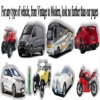Product Catalog of charging station
Product Catalog of charging station
Please receive attached video and parameter files for battery charger.
For battery charger, we have three kinds of battery capacities:34kwh, 65kwh and 132kwh.
Our factory can also accept customization
Please check a few of our latest 2023 Biggest selling e-power cars
INTRODUCTION AND RELATED CONCEPTS ABOUT SOLAR AND ELECTRIC VEHICLES
What is an electric or solar vehicle?
Put simply, an electric car is a one powered by an electric motor or solar energy rather than a traditional petrol/diesel engine. This electric motor is powered by rechargeable batteries that can be charged by common household electricity.
Brief history about electric vehicles.
Electric cars are nothing new. Interest in motor vehicles increased greatly around the 1900s and at that time there were about twice as many electric cars on the road than petrol/diesel cars. It wasnt until the 1920s that interest in electric cars dwindled. The reason was that electric cars were limited by their low top speeds and low range (just a few miles). The limited maximum speed of electric cars (up to 30mph) limited their practicality.
Interest in electric cars returned following the energy crises of the 1970s and 80s; with the availability and price of oil being shown to be increasingly volatile, people could see the potential benefits of battery-powered cars. A few big car companies brought out models and some were sold to environmentally-minded members of the public. However, in general electric vehicles were still losing out to the style and lower price of their petrol-fuelled cousins.
In the 2000s, the development of hybrid vehicles, plus another fuel crisis, saw the technology adopted by larger numbers than ever before. Teslas Roadster, which went on sale in 2008, was a game changer for the industry. The attractive design and extended range of the Roadster appealed to a larger market than ever before and encouraged competitors such as Chinese auto makers and Euro auto makers to launch their own models.
As of today, there are more than two million pure electric and solar cars and vans owned globally of which seventy percent are locally produced and manufactured in China. China has become a leading giant in this era of electric vehicles for the past seven years.
How do electric cars work?
There are two types of EV technology: hybrid and pure electric.
FULLY ELECTRIC CAR
The main parts in an electric car are a rechargeable battery, controller and electric motor. First, the battery is powered. Then the controller converts the current from DC-AC so that it can be used by the motor. The motor converts electrical energy to mechanical energy.
HYBRID CAR
The same technology exists in hybrid cars, alongside a small gasoline engine running a generator. This powers the car at cruising speed, and batteries provide extra power when accelerating. Batteries can recharge themselves when the car is decelerating or standing still. Hybrid technology means that your petrol goes much further, saving you money and reducing pollution to our environment.
What are the benefits of electric cars?
They produce no tailpipe emissions, so are better for the planet.
They are exempt from road tax and from the London Congestion Charge.
They often have a smoother drive than petrol cars.
They are cheaper to run.
Do not need much maintenance, as they have fewer moving parts.
Electric cars are efficient, require minimal maintenance and deliver impressive performance.
What are the downsides of electric cars?
They can have a comparatively limited range. This depends on the model, the weather and the style of driving.
Depending on the car and the charger, they can take a long time to charge for the slow charge.
Batteries may need replacing after 5-10 years in order to retain efficiency. After a few thousand few charges, the battery will lose its ability to hold charge as effectively.
How safe are electric cars?
Electric cars are measured by the same safety standards as standard cars, and many have the highest 5-star ratings. There have been (very rare) reports of lithium ion batteries catching fire and exploding, but extra safety measures are installed to ensure this cannot happen. These include fuses and circuit breakers, plus coolant run through battery packs to keep them at a low temperature.
Fans of petrol cars argue that chemicals in an electric car battery will catch fire in the event of a crash. However, a tank full of petrol is about as flammable as you can get. This is why some people believe electric cars are in fact the safer option.
Economic benefits and analysis of electric cars used as taxi and online hailing cars
In order to make an intuitive comparison of the economic benefits of electric cars used as taxis and online hailing cars such uber, we have done a comparative analysis of a case study of economic benefits according to the actual cases of gasoline taxis and electric taxis in China. We hope you can truly understand the concept of it.
Calculation of operating costs of fuel taxis and electric taxis;
To give you a clear picture of the cost of the two types of taxi. We base our data on the operating costs of existing electric vehicles and taxis in China. The actual operating costs of the two types of vehicles are analyzed and compared.
.
Related Calculations:
1.1.1. Known operating costs of gasoline taxis:
According to the actual statistics, the average mileage of city taxi every day is 250-300 kilometers. The upper limit is about 300 km per day on average. Gasoline in China costs $1.15 a litre. 1.6 liter engine models, fuel consumption per 100 kilometers 6-7 liters (due to urban traffic congestion fuel consumption of 7L / 0.07 L per kilometer fuel consumption), 300 kilometers fuel consumption of about 21 L.
Cost of daily fuel consumption of a petrol taxi: = unit price of fuel X fuel consumption of 0.07L per km X average mileage of 300 km
= $1.15 X 0.07l X 300km
= US $24.15
Cost of driving a petrol taxi at a cost per kilometre:
= The unit price of gasoline is $1.15 X 0.07 L per kilometer
= 1.15 X 0.07 =0.08 USD;
Known operating costs of electric taxis:
According to the charging cost of electric vehicles in China. Charging points cost $0.10 per kilowatt-hour, and a slow charge requires 30 kilowatt-hours and a range of 300 to 400 kilometers. Charging costs about $3.00 , B: About $0.01 per kilometer on average.
Cost of running an electric taxi on a daily basis:
= $0.1 per KWH X 30 KWH required for slow charging= $3. This means when you charge the car at home overnight the cost of the electricity for daily basis is $3.
Cost of running an electric taxi per kilometer:
=$0.10 per KWH X 30 KWH / 300=$0.01
1.2. Calculation of annual operating cost of fuel taxi and electric taxi:
In China, taxis operate almost without holidays and people rest all the time. Taxis work for about 350 days a year. Annual fuel consumption cost of a gasoline taxi: Cost per day X 350 days = $24.15 X 350 = $8452.50
Annual cost of electric taxi: Charging cost per day X 350 days = $3.00 X 350 = $1050.00 Operating cost gap between fuel taxi and electric taxi:
$8452.50 - $1050.00 = $7402.50
CostFuel taxi driving costsEV taxi driving costsOperating cost between fuel taxi and electric TaxiThe daily cost of driving a taxi$ 24.15$ 3.00$21.5The cost of driving a taxi per kilometer$ 0.08$ 0.01$0.07The annual cost of driving a taxi$ 8452.50$ 1050.00$7402.50Note: 1, this analysis is only the savings of taxi operating costs. It does not include the average profit of the taxi industry.2. The charging of electric vehicles is divided into slow charging and fast charging. Fast charging requires the construction
of charging piles, while slow charging can be charged at home and can be 100% full 2.1 Comparison table of economic benefit analysis between fuel taxi and electric taxi
2.2 , Return on investment, operating cost and fuel cost savings of electric taxi;
The above bar chart of return on investment, operating cost and fuel cost savings of electric taxi is calculated based on the following Young 400 model. The quoted price is the import price of Chinese factory, excluding freight, import tariff and importers profit.
More information on the import cost and operating cost of electric taxi:
In order to protect the environment and reduce carbon emissions, many governments have formulated preferential policies of tariff/related taxes and direct government subsidies for electric taxis.
f the local automobile assembly factory KD assembles electric vehicles, the freight cost, tariff/tax and emission reduction subsidy of electric vehicles will receive greater government support. The cost of buying a car for the end consumer will be further reduced.
, because the failure rate of electric vehicles is far less than that of fuel vehicles. Maintenance costs are much lower than gasoline cars, which can greatly save vehicle maintenance costs.
With the continuous improvement of electric vehicle technology, the manufacturing cost of electric vehicle will decrease year by year. The new technology of battery reactivation has greatly extended the service life of electric vehicles.
3.5 Major automobile manufacturers in the world have set a timetable for comprehensive new energy auto-mobilization, gradual reduction of petroleum fuel vehicles, and complete cessation of production and sales of traditional vehicles.
Comprehensive new energy auto-mobilization
CountryStop selling petrol-fuelled carsNote: production /sales of EV by country in 2020Germany2030 year395.000Japan2035 yearJapan is taking the hybrid technology route. Missed the opportunity to
develop electric vehicles.SUA2030 year322.000 French 2035 year190.500UK2030 year175.000Netherlands2025 year8.8,000 China2030 year 2020,Chinas output of EV exceeds that of all other countries combined 1.9 million.and will exceed 5 millions in 2023.
In 2020, the global growth rate of EV was as high as 38%, and the development of new energy has become a global consensus.
Selection of electric taxi models and construction of charging stations:
Model selection. The range increase is based on increased battery power and increased cost. The selection of electric vehicles should be based on scenarios suitable for use. What is appropriate for your purpose is best option to select.
Charging station construction. We know that not every country is equipped with charging stations, and for developing countries, home power charging is combined with taxi companies building rapid charging stations intensively. In fact, fast charging stations are good projects with constant profit margins.
About the project of investing in assembly plants for fuel cars and electric taxi
Production line budget of taxi assembly plant under SKD condition.
SKD assembly production includes: painting, final assembly and testing.
CKD assembly line includes: welding, painting, final assembly and testing.
Development path of ELECTRIC vehicle KD assembly plant project: From SKD -to-CKD -to- Localization.
Conclusion:
At the beginning of the project, the investment of electric taxi (including electric online hailing) is higher than that of traditional fuel-powered taxi, but the return on investment is much higher than that of traditional fuel-powered taxi.
Installing electric taxis locally reduces transport and production costs, while securing government support for preferential policies. The cost advantage is obvious.
3. Buying new energy cars to replace traditional fuel cars is a big historical trend. Early preparation gives you a head start.
4. At the same time, taxi companies can build charging facilities to meet their business needs.

 Aircraft
Aircraft Business Opportunities / Investments
Business Opportunities / Investments Chemicals
Chemicals Clearance/Liquidations
Clearance/Liquidations Commodities ( Rice, Sugar , Soy Grains, Minerals and Ore)
Commodities ( Rice, Sugar , Soy Grains, Minerals and Ore)  Fire/Rescue/Medical
Fire/Rescue/Medical Food/Beverages
Food/Beverages  Housing
Housing Military Equipment/Unrestricted
Military Equipment/Unrestricted Military/Police
Military/Police Pet Supply
Pet Supply Petroleum Product
Petroleum Product Plant and Equipment
Plant and Equipment Recyclable-HMS-PVC
Recyclable-HMS-PVC Ships/Vessels/Boats
Ships/Vessels/Boats Solar/Wind-Power
Solar/Wind-Power Vehicles
Vehicles Wanted
Wanted Zoo supply (unrestricted )
Zoo supply (unrestricted )


